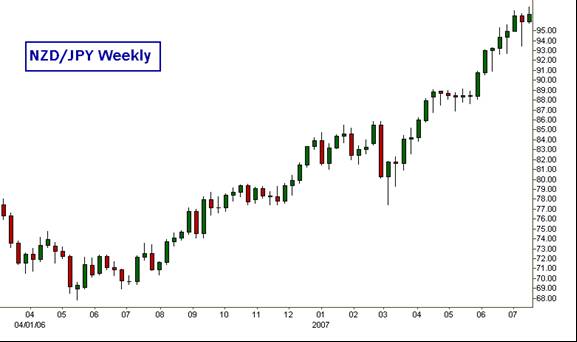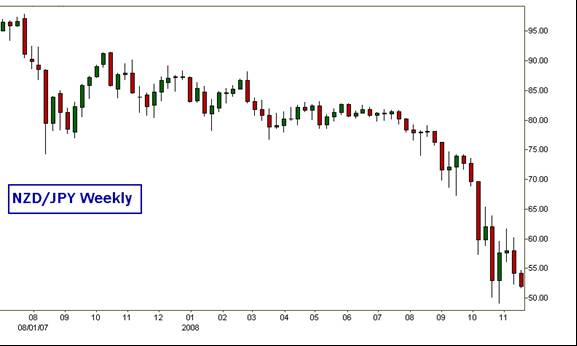The New Risks of a Popular Forex Trading Strategy
The Decline of the Carry Trade
The carry trade has been one of the most popular forex trading strategies in the last few years, but with recent changes in the currency market and increased volatility, the carry trade now looks like a losing proposition. The question that is on most traders minds is, will the carry trade ever come back as a viable trading strategy? The answer to this question is murky at best, depending on the global economic conditions and stability in the currency markets.
How does the Carry Trade work?
To understand why the carry trade isn’t working, one must first understand what the carry trade is. The carry trade is a trade where a currency trader or speculator is attempting to not only gain from the rise or decline of the currency pair, but also the interest rate differential between the two currencies.
When carry trading, the trader buys (or goes long) the currency with the higher interest yield while selling (or going short) the currency with the lower interest. The speculator is attempting to capture the interest rate differential as well as any appreciation in the currency. The carry trader is often more interested in the positive interest earned on the currency pair rather than the profits from the trade itself.
Let’s take a look at a sample carry trade:
1. Trader Buys New Zealand Dollars (Earns 6.5%)
2. At the same time, Trader Sells Japanese Yen (Pays 0.30%)
3. If the currency pairs stays at the same rate for the whole year, trader makes 6.15% (Interest Rate Difference)
If this is a 100k position, the trader has earned 6.15% interest on 100,000. With 10:1 leverage, the trader put up 10k and earned $6,150 NZD.
The New Zealand/Japanese Yen currency pair has been a great example of this strategy in the recent past. Forex traders bought the pair not for economic growth in the New Zealand economy, but the carry trade opportunity. Currency traders jumped at the chance to earn the 8 percent interest rate that the Reserve Bank of New Zealand was offering at the time while simultaneously, paying a cost of 0.5 percent for the Japanese Yen.
This 7.5% rate on margined funds lead to huge potential gain and this decision helped money managers garner a high return on a rise in the currency as the New Zealand dollar appreciated against the Yen while also gaining from the wide difference in interest rates between the countries.

Why has the carry trade started to fail?
All good things must come to an end, and this includes the carry trade. Three major concepts have recently taken down this seemingly infallible strategy. With that said, conditions may again become favorable once the market downturn runs its course.

Interest Rates Cuts
Many global economies are in jeopardy and desperate to free markets. As a result, they have decided to begin cutting interest rates. This has caused traders and money managers alike to reconsider their already long term carry trade positions. The eight percent return they were previously getting is now a smaller five to six percent return.
Although the Japanese yen, a favorite funding currency for the carry trade has also slightly lowered their interest rate from .5% to .3% their interest rate differential is still less. This shrinking differential became too small to compensate against increasing losses as the New Zealand dollar began to weaken. This led to a mass asset reallocation so traders could cut losses and try to build funds elsewhere.
Increased Risk Aversion
As market volatility increased, which can be seen in the large increase in average daily ranges, investors became more fearful of risky assets and decided to close these positions. As short term benefits for the carry trade and many stocks decreased, traders closed out of their carry trade positions from the FX market. Carry trades work best in less volatile environments as the pairs most suited for them are typically riskier assets. Carry traders are now keeping their distance.
Government Intervention
Government forex intervention is rare but it can occur most often as a tool when a currency either rises or declines faster than central bank expectations. It has rarely been used or mentioned as carry traders exited en masse. The absence of intervention helped to fuel a new generation of sellers as favorite carry candidates took a beating. The list included popular carry trade currencies like the Australian and New Zealand dollars, Euro and British Pound.Had central bank policy makers hinted at some potential action. Unfortunately, this was not the case and there was nothing to curb the downfall.
Looking to the future
Volatile markets and an aversion to risk won’t last forever. Forex, like the equity markets typically recover along when investor’s appetite for higher returns increases. There have been similar situations that appeared in the last ten years, and carry trades will likely repeat once volatile markets have calmed. This opportunity will take some time to resurface, but it will be worth the wait.
For when conditions are ideal again, here is what to look for in a carry trade.
1. Large interest rate differentials:
If the British Pound has a 4.50% interest rate and the Japanese Yen has a 0.50% interest rate, it would likely be a good pair to look at.
2. Healthy Economy of the Higher Interest Rate Currency
This is partially why the carry trade is not currently working. Be sure to watch out for this when volatility calms.
3. Low Market Volatility
The carry trade works best when market volatility is low.
Richard Lee is the Chief Currency Strategist for Online Forex Trading, a forex website that focuses on providing unbiased forex broker reviews as well as forex news. Richard has been featured on Bloomberg, FX Street, Yahoo Finance and DailyFX.
